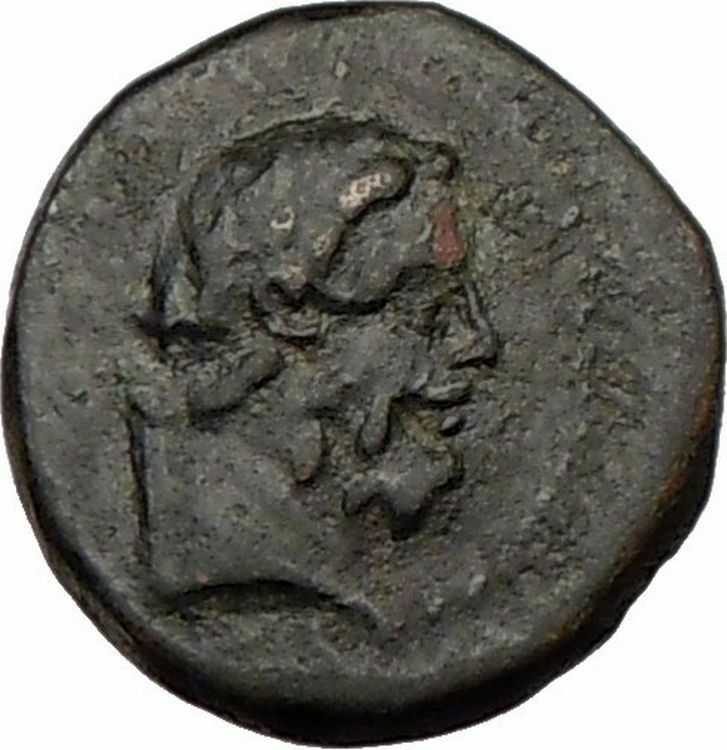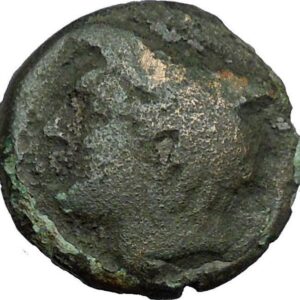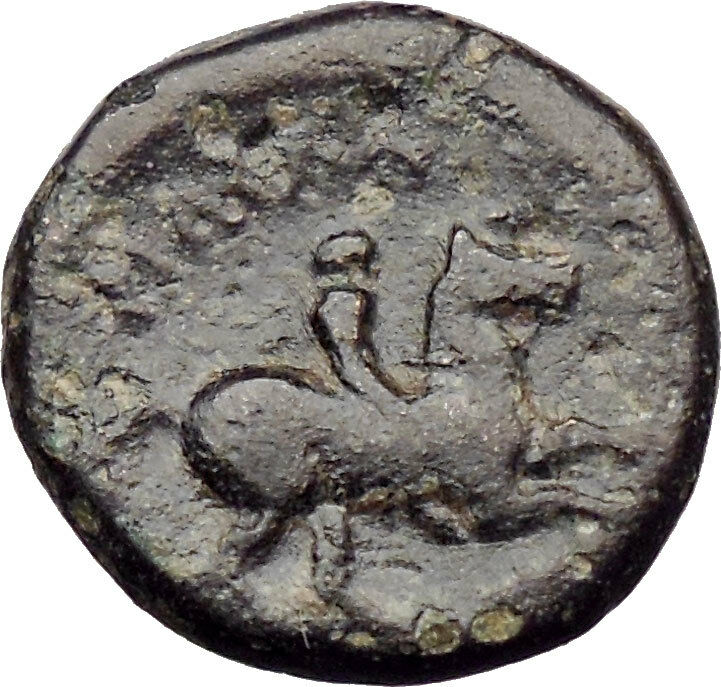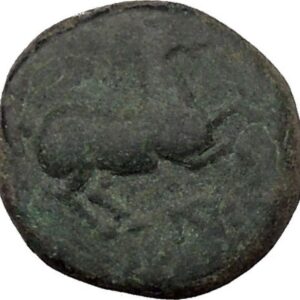|
Greek city of Apameia in Seleukis and Pierea
Bronze 20mm (6.71 grams) Dated SE 304, struck 9/8 B.C.
Reference: RPC I 4353; HGC 9, 1425.
Head of Dionysus right, wearing ivy wreath; ME monogram to left.
ΑΠΑΜΕΩΝ ΤΗΣ ΙΕΡΑΣ / ΚΑΙ ΑΣΥΛΟΥ, Thyrsos; ΔΤ (date) to inner left.
About 50 miles south of Antiocheia, Apameia was named after Apame, wife of Seleukos I.
You are bidding on the exact item pictured, provided with a Certificate of Authenticity and Lifetime Guarantee of Authenticity.
 Dionysus is the god of the grape harvest, winemaking and wine, of ritual madness, fertility, theatre and religious ecstasy in Greek mythology. Alcohol, especially wine, played an important role in Greek culture with Dionysus being an important reason for this life style. His name, thought to be a theonym in Linear B tablets as di-wo-nu-so (KH Gq 5 inscription), shows that he may have been worshipped as early as c. 1500-1100 BC by Mycenean Greeks; other traces of the Dionysian-type cult have been found in ancient Minoan Crete. His origins are uncertain, and his cults took many forms; some are described by ancient sources as Thracian, others as Greek. In some cults, he arrives from the east, as an Asiatic foreigner; in others, from Ethiopia in the South. He is a god of epiphany, “the god that comes”, and his “foreignness” as an arriving outsider-god may be inherent and essential to his cults. He is a major, popular figure of Greek mythology and religion, and is included in some lists of the twelve Olympians. Dionysus was the last god to be accepted into Mt. Olympus. He was the youngest and the only one to have a mortal mother. His festivals were the driving force behind the development of Greek theatre. Modern scholarship categorises him as a dying-and-rising god. Dionysus is the god of the grape harvest, winemaking and wine, of ritual madness, fertility, theatre and religious ecstasy in Greek mythology. Alcohol, especially wine, played an important role in Greek culture with Dionysus being an important reason for this life style. His name, thought to be a theonym in Linear B tablets as di-wo-nu-so (KH Gq 5 inscription), shows that he may have been worshipped as early as c. 1500-1100 BC by Mycenean Greeks; other traces of the Dionysian-type cult have been found in ancient Minoan Crete. His origins are uncertain, and his cults took many forms; some are described by ancient sources as Thracian, others as Greek. In some cults, he arrives from the east, as an Asiatic foreigner; in others, from Ethiopia in the South. He is a god of epiphany, “the god that comes”, and his “foreignness” as an arriving outsider-god may be inherent and essential to his cults. He is a major, popular figure of Greek mythology and religion, and is included in some lists of the twelve Olympians. Dionysus was the last god to be accepted into Mt. Olympus. He was the youngest and the only one to have a mortal mother. His festivals were the driving force behind the development of Greek theatre. Modern scholarship categorises him as a dying-and-rising god.
The earliest cult images of Dionysus show a mature male, bearded and robed. He holds a fennel staff, tipped with a pine-cone and known as a thyrsus. Later images show him as a beardless, sensuous, naked or half-naked androgynous youth: the literature describes him as womanly or “man-womanish”. In its fully developed form, his central cult imagery shows his triumphant, disorderly arrival or return, as if from some place beyond the borders of the known and civilized. His procession (thiasus) is made up of wild female followers (maenads) and bearded satyrs with erect penises. Some are armed with the thyrsus, some dance or play music. The god himself is drawn in a chariot, usually by exotic beasts such as lions or tigers, and is sometimes attended by a bearded, drunken Silenus. This procession is presumed to be the cult model for the human followers of his Dionysian Mysteries. In his Thracian mysteries, he wears the bassaris or fox-skin, symbolizing a new life. Dionysus is represented by city religions as the protector of those who do not belong to conventional society and thus symbolizes everything which is chaotic, dangerous and unexpected, everything which escapes human reason and which can only be attributed to the unforeseeable action of the gods.
Also known as Bacchus, the name adopted by the Romans and the frenzy he induces, bakkheia. His thyrsus is sometimes wound with ivy and dripping with honey. It is a beneficent wand but also a weapon, and can be used to destroy those who oppose his cult and the freedoms he represents. He is also called Eleutherios (“the liberator”), whose wine, music and ecstatic dance frees his followers from self-conscious fear and care, and subverts the oppressive restraints of the powerful. Those who partake of his mysteries are possessed and empowered by the god himself. His cult is also a “cult of the souls”; his maenads feed the dead through blood-offerings, and he acts as a divine communicant between the living and the dead.
In Greek mythology, he is presented as a son of Zeus and the mortal Semele, thus semi-divine or heroic: and as son of Zeus and Persephone or Demeter, thus both fully divine, part-chthonic and possibly identical with Iacchus of the Eleusinian Mysteries. Some scholars believe that Dionysus is a syncretism of a local Greek nature deity and a more powerful god from Thrace or Phrygia such as Sabazios or Zalmoxis.
Apamea or Apameia (Greek: Απάμεια; Arabic أفاميا or آفاميا, Afamia) was a treasure city and stud-depot of the Seleucid kings, was capital of Apamene, on the right bank of the Orontes River. (Steph. B. s. v.; Strabo xvi. p. 752; Ptolemy v. 15. § 19; Festus Avienus, v. 1083; Anton. Itin.; Hierocles). Its site is found about 55 km to the northwest of Hama, Syria, overlooking the Ghab valley. Previously known as Pharmake, it was fortified and enlarged by Seleucus I Nicator in 300 BC, who so named it after his Bactrian wife, Apama – not his mother, as Stephanus asserts; compare Strabo, p. 578). In pursuance of his policy of Hellenizing Syria, it bore the Macedonian name of Pella. The fortress was placed upon a hill; the windings of the Orontes, with the lake and marshes, gave it a peninsular form, whence its other name of Cherronêsos. Seleucus had his commissariat there, 500 elephants, with 30,000 mares, and 300 stallions. The pretender, Diodotus Tryphon, made Apamea the basis of his operations. (Strab. l. c.) Located at a strategic crossroads for Eastern commerce, the city flourished to the extent that its population eventually numbered half a million. It was one of the four cities of the Syrian tetrapolis.
 Photograph of a tomb at Apamea, taken on albumen ca. 1860-1890. Part of the A.D. White architectural photography collection of Cornell University Library Photograph of a tomb at Apamea, taken on albumen ca. 1860-1890. Part of the A.D. White architectural photography collection of Cornell University Library
Josephus (Ant. xiv. 3. § 2) relates, that Pompey marching south from his winter quarters, probably at or near Antioch, razed the fortress of Apamea in 64 BC whence the city was annexed to the Roman Republic. In the revolt of Syria under Q. Caecilius Bassus, it held out against Julius Caesar for three years till the arrival of Cassius, 46 BC. (Dion. Cass. xlvii. 26-28; Joseph. Bel. Jud. i. 10. § 10.) On the outbreak of the Jewish War, the inhabitants of Apamea spared the Jews who lived in their midst, and would not suffer them to be murdered or led into captivity (Josephus, Bell. Jud. ii. 18, § 5). Destroyed by Chosroes I in the 7th century it was partially rebuilt and known in Arabic as Famia or Fâmieh; and destroyed by an earthquake in 1152. In the Crusades it was still a flourishing and important place and was occupied by Tancred. (Wilken, Gesch. der Ks. vol. ii. p. 474; Abulfeda, Tab. Syr. pp. 114, 157.)
The acropolis hill is now occupied by the ruins called Kalat el-Mudik (Kŭlat el-Mudîk). The ruins of a highly ornamental character, and of an enormous extent, are still standing, the remains, probably, of the temples of which Sozomen speaks (vii. 15); part of the town is enclosed in an ancient castle situated on a hill; the remainder is to be found in the plain. In the adjacent lake are the celebrated black fish, the source of much wealth.
Both the Jerusalem Targumim considered the city of Shepham (Num. xxxiv. 11) to be identical with Apamea. Since Apamea virtually belonged to Rabbinic Palestine, the first-fruits brought by Ariston from that town were accepted for sacrifice in Jerusalem (Mishnah Ḥal. iv. 11). Apamea remains a titular see of the Roman Catholic Church, Apamenus in Syria; the seat has been vacant since the death of the last bishop in 1974.
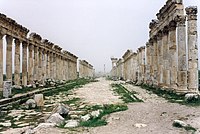
View of Apamea’s ruins, Syria.
|





 Dionysus is the god of the grape harvest, winemaking and wine, of ritual madness, fertility, theatre and religious ecstasy in Greek mythology. Alcohol, especially wine, played an important role in Greek culture with Dionysus being an important reason for this life style. His name, thought to be a theonym in Linear B tablets as di-wo-nu-so (KH Gq 5 inscription), shows that he may have been worshipped as early as c. 1500-1100 BC by Mycenean Greeks; other traces of the Dionysian-type cult have been found in ancient Minoan Crete. His origins are uncertain, and his cults took many forms; some are described by ancient sources as Thracian, others as Greek. In some cults, he arrives from the east, as an Asiatic foreigner; in others, from Ethiopia in the South. He is a god of epiphany, “the god that comes”, and his “foreignness” as an arriving outsider-god may be inherent and essential to his cults. He is a major, popular figure of Greek mythology and religion, and is included in some lists of the twelve Olympians. Dionysus was the last god to be accepted into Mt. Olympus. He was the youngest and the only one to have a mortal mother. His festivals were the driving force behind the development of Greek theatre. Modern scholarship categorises him as a dying-and-rising god.
Dionysus is the god of the grape harvest, winemaking and wine, of ritual madness, fertility, theatre and religious ecstasy in Greek mythology. Alcohol, especially wine, played an important role in Greek culture with Dionysus being an important reason for this life style. His name, thought to be a theonym in Linear B tablets as di-wo-nu-so (KH Gq 5 inscription), shows that he may have been worshipped as early as c. 1500-1100 BC by Mycenean Greeks; other traces of the Dionysian-type cult have been found in ancient Minoan Crete. His origins are uncertain, and his cults took many forms; some are described by ancient sources as Thracian, others as Greek. In some cults, he arrives from the east, as an Asiatic foreigner; in others, from Ethiopia in the South. He is a god of epiphany, “the god that comes”, and his “foreignness” as an arriving outsider-god may be inherent and essential to his cults. He is a major, popular figure of Greek mythology and religion, and is included in some lists of the twelve Olympians. Dionysus was the last god to be accepted into Mt. Olympus. He was the youngest and the only one to have a mortal mother. His festivals were the driving force behind the development of Greek theatre. Modern scholarship categorises him as a dying-and-rising god. Photograph of a tomb at Apamea, taken on albumen ca. 1860-1890. Part of the A.D. White architectural photography collection of Cornell University Library
Photograph of a tomb at Apamea, taken on albumen ca. 1860-1890. Part of the A.D. White architectural photography collection of Cornell University Library


